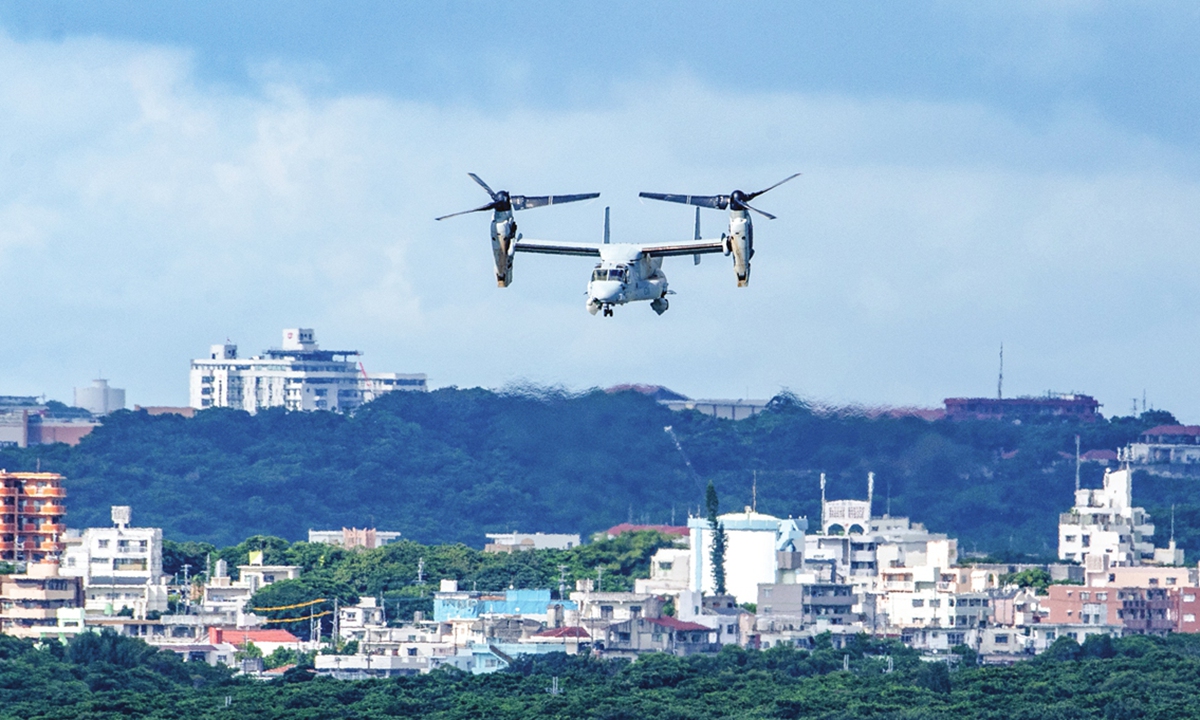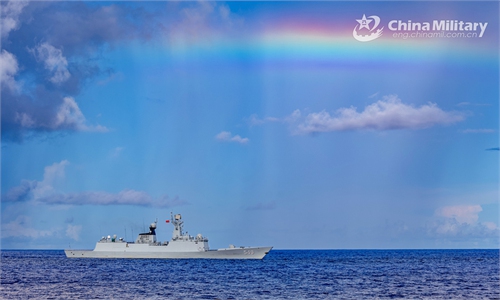US Marines relocate from Okinawa to Guam; US strategy of encircling China using island chains unchanged, says expert

This photo taken on August 23, 2022 shows a US military Osprey aircraft at the US Marine Corps Air Station Futenma in the centre of the city of Ginowan, Okinawa prefecture. Photo: AFP
US Marines stationed in Okinawa reportedly started to transfer to Guam on Saturday after years of complaints by local residents over issues caused by the US' military presence there including noise, pollution, accidents and crimes. A Chinese military expert said on Sunday that the US' strategy of militarily encircling China using island chains is not changed, and the relocation is not a sign of the encirclement becoming less tight.
The partial transfer of US Marines from Okinawa to Guam began on Saturday, 12 years after Japan and the US agreed on their realignment to reduce the heavy burden of American troop presence on the southern Japanese island. The relocation started with 100 members of III Marine Expeditionary Force stationed on Okinawa moving to the Pacific island for the initial logistical work, AP reported.
Under the plan agreed between Tokyo and Washington in April 2012, about 9,000 of the 19,000 Marines currently stationed on Okinawa are to be moved out of Okinawa, including about 4,000 of them to be moved to Guam in phases, AP said, noting that Okinawa, which was under US postwar occupation until 1972, is still home to a majority of the more than 50,000 American troops based in Japan under a bilateral security pact, while 70 percent of US military facilities are on Okinawa, which accounts for only 0.6 percent of Japanese land.
Many Okinawans have long complained about the heavy US military presence on the island, and say Okinawa faces noise, pollution, aircraft accidents and crime related to American troops, the AP noted.
Fu Qianshao, a Chinese military expert, told the Global Times on Sunday that the US' long-term military presence in Okinawa has long been opposed by local residents, as it has brought significant negative impact to their normal daily lives and work, as well as their security.
The AP report said that the relocation is likely to be welcomed by local residents, but how much improvement they will feel is uncertain because of the rapid Japanese military buildup on Okinawan islands as a deterrence to "threats from China."
Citing sources, Japan's Kyodo News reported in late November that the US Marine Littoral Regiment, which possesses the multiple-launch High Mobility Artillery Rocket System (HIMARS), will be deployed along the island chain stretching from the Japanese prefectures of Kagoshima and Okinawa toward the island of Taiwan in the event of a "Taiwan contingency."
The transfer of US troops from Okinawa on the first island chain to Guam on the second island chain does not mean that the US military encirclement around China is becoming less tight, Fu said.
Fu noted that the US has been scattering some of its forces from the first island chain to the second and third island chains lately. With the Chinese military's rapid development, the Chinese People's Liberation Army's (PLA) warships and warplanes have become capable of operating in and over far seas, in addition to the deployment of more types of long-range missiles. This has led to US' worries about the safety of its military assets along the first island chain.




